 |
 |





 |
 |
 |
 |
 |
 |
Resurgent floods take heavy toll on state’s highway system
|
 |
 |
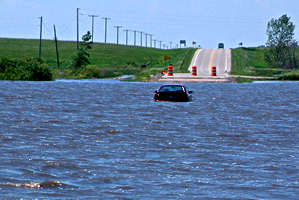 |
|
The swollen Wild Rice
River engulfs an abandoned car on Hwy 200 east of Mahnomen. Similar scenes
played out throughout Minnesota as floods from record-level rains closed
roads, damaged bridges and disrupted traffic throughout the state. Photo
by Dennis Redig, Detroit Lakes
|
Fed by torrential rains, floodwaters disrupted highway travel in nearly every
region of Minnesota during the past week, from the heart of the Twin Cities
to the state’s extremities.
Floodwaters continued their rampages, damaging bridges, washing out shoulders
and sections of roadway and disrupting traffic and the daily lives of thousands
of citizens.
Mn/DOT crews joined with the National Guard, law enforcement agencies, relief
agencies and thousands of volunteers to deal with the effects of widespread
flooding in northern Minnesota, the area hit hardest by the floods.
In Ada, the Norman County city that experienced severe flooding just a week
ago, Mn/DOT crews helped construct an earthen dam to withstand another assault
by flooding from the Marsh and Wild Rice rivers.
"We hauled clay and sand to help the city and Norman County and now we are
hauling rock to reinforce damaged piers that closed a bridge on Hwy 32 near
Twin Valley," said Terry Sorenson, maintenance supervisor at Crookston. "We’ll
have to detour traffic to Hwy 59; it’s underwater but at least its open."
Crews from the Bemidji District are monitoring other bridges and signing detours
as the floodwaters advance.
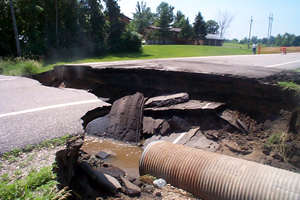 |
|
A 48-inch culvert collapsed
under Hwy 24 near Litchfield, forcing the road to be closed until crews
from Willmar/District 8 could make repairs. Photo by Marcia Lochner,
Owatonna
|
Flooding has already forced closing Hwy 200 west of Ada and between Mahnomen
and Hwy 32.
At Mahnomen, where floodwaters are now receding, Dennis Redig, Detroit Lakes
maintenance superintendent, said his crews are coping with washouts, deep cuts
gouged by rushing floodwaters, water-covered roads and bridges that need constant
monitoring. Waters from the Wild Rice River knocked out a bridge on Hwy 9 between
Borup and Felton, necessitating a long detour.
"It’s not pretty," Redig said. "The water is going down, but that means it’s
going up somewhere else."
Near Roseau, the city devastated by heavy flooding little more than a week
ago, Hwy 310 remains closed north of town. Hwy 89 in Roseau is restricted to
local traffic because of dikes placed on the roadway.
Several highways in the Bemidji District that were closed are now open including
Hwy 11 in Roseau and Hwy 11 between Warroad and Baudette. Other state highways
in the region have reopened as well. Many, however, remain closed.
Washouts caused the Brainerd District to close a two-mile section of Hwy 25
between Montrose and Buffalo. Water over Hwy 12 near Howard Lake limited travel
on that highway only to trucks on June 25 until the waters receded.
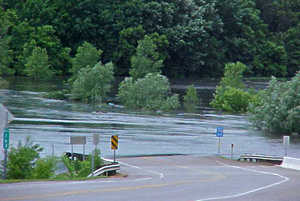 |
|
Flooding from the Zumbro
River caused widespread disruption in Rochester/District 6, including
closure of Hwy 57 and Hwy 60 in several locations. Above, water covers
Hwy 60 west of Kenyon. Photo by Ken Ahlman, Owatonna
|
The flooding reached the Rochester District when the Zumbro River went over
its banks, washing out a 300-foot section of Hwy 58 north of Zumbrota. The Zumbro
also forced closing a section of Hwy 57 north of Wanamingo because of possible
damage to a bridge there. Flooding also required closing a section of Hwy 60
between Kenyon and Zumbrota until floodwaters receded.
In the Mankato District, high water from the Rush River required detouring
traffic on Hwy 93 between Hwy 169 and Henderson. The closure also affects a
detour for the new Hwy 169/Hwy 19 interchange project which used Hwy 93 as an
alternate route. The detour was rerouted on Sibley County roads and will remain
in place until the highway is safe for motorists’ use.
In southwestern Minnesota, water covered parts of major roadways in the Willmar
District including Hwy 24 near Litchfield, Hwy 7 in Hutchinson and Hwy 59 south
of Marshall. Maintenance crews flagged traffic through the area. On June 25,
rushing water knocked out a culvert on Hwy 24 north of Litchfield, closing the
highway.
Heavy rains also affected the DuIuth District. Near Marcell, north of Grand
Rapids, a rain-triggered mudslide washed out a section of Hwy 38, closing a
15-mile section of the roadway. Crews are working around the clock to make emergency
repairs and reopen the popular scenic highway.
The Twin Cities region also received heavy rains on Sunday, June 23, and Monday,
June 24, that forced Mn/DOT to detour traffic on I-35W at Diamond Lake Road
in south Minneapolis on the morning of June 24 for a short time.
Storm water runoff caused the flooding and resulted in traffic delays on the
heavily traveled freeway interchange.
The most devastating effects from the floods, however, remain centered on north
central and northwestern regions of the state.
The flooding is taking its toll on Mn/DOT crews and resources, Sorenson said.
There is little his crews can do to repair damage until the floodwaters eventually
recede.
"We’ll start all over again when the water goes down," he said. "We’ll be making
all the repairs we made last week all over again."
By Craig Wilkins
Jon Livingston, aka KBOMNM, uses ham radio skills
to support flood relief
Co-workers at Baxter call him Jon or Doc, but his fellow ham radio
operators know Jon Livingston as KBOMNM, his radio call sign.
Livingston took his ham operator skills and his expertise as a Mn/DOT
senior electronics technician to support American Red Cross flood relief
efforts in northern Minnesota.
Using a new law that allows state employees to receive regular pay
while supporting Red Cross relief efforts, Livingston worked in flood-ravaged
Roseau and in Warroad and Baudette June 13–16 installing telephone lines,
fax machines and radios for relief workers.
Livingston also used his mobile ham radio to help a Red Cross public
affairs officer borrow a printer from a law enforcement agency.
The Red Cross asked Livingston for assistance because of his role as
an amateur radio emergency services coordinator and his experience with
industrial telephone systems.
"I always try to support public service," he said, "and to demonstrate
how ham radio operators can support emergency relief efforts."
|
|
back

|
 |
Study shows traffic congestion in Twin Cities costs drivers more in time, money
|
 |
 |
Minneapolis-St. Paul and Atlanta are tied at second in the rate of congestion
growth, according to a report released June 20 by the Texas Transportation Institute,
an independent transportation research agency. San Antonio had the highest rate
of congestion growth, based on data collected between 1994 and 2000.
The annual TTI Urban Mobility Report also indicates that the Twin Cities area
outranks all other large metro areas in population growth, travel delays, wasted
fuel and congestion costs.
The report shows that traffic tie-ups cost the average Twin Cities commuter
more than $1,000 during 2000 in lost time and wasted fuel—$330 more than the
previous year. Commutes now take 38 percent longer at rush hour than at other
times. A trip that takes 20 minutes during off-peak hours takes 28 minutes during
morning and evening rush hours. The time can increase dramatically when crashes,
severe weather and road construction occur.
"Congestion in the metro area is getting worse and at a faster pace than most
of the country," said Commissioner Elwyn Tinklenberg. "It’s obvious that commute
times and shipping and delivery schedules are more unpredictable due to congestion
delays. The continuing lack of transportation funding is taking its toll on
the system and has caused us to defer projects that would at least address some
of the problems."
On June 11 Tinklenberg announced that 163 projects during the next decade would
be deferred because of lack of funding. The number includes a three-year delay
for the $100 million "Unweave the Weave" projects to separate the I-35E and
I-694 commons area in Maplewood, replacement of the I-35E Cayuga Bridge in St.
Paul, and the addition of a third lane on Hwy 100 between 35th Avenue and Cedar
Lake Road in Golden Valley.
An important part of controlling congestion growth is to make road and transit
systems more reliable, according to the TTI report.
"Predictable and regular travel times have a growing value for businesses and
urban travelers. Crashes, vehicle breakdowns, weather, special events and road
work can have a dramatic effect on the reliability of transportation systems,"
the report notes.
In 1999, TTI found it would take the addition of 49 lane miles per year just
to maintain the current level of congestion in the Twin Cities. That figure
more than doubled in 2000, jumping to 99 lane miles to maintain congestion levels.
"Even if we could physically build to this rate, would we want to?" Tinklenberg
asked. "There isn’t enough space, money and public approval to add enough road
space to create an acceptable condition. Of course, people want bottleneck removals
and expansion of roads, but they don’t want a roads-only approach. Improved
bus service, car pool lanes, light rail transit and commuter rail provide choices
and give commuters the option of avoiding congestion altogether."
The TTI Urban Mobility Report is funded by a consortium of 10 state transportation
agencies, including Mn/DOT. A member of the Texas A&M University System,
TTI is the largest university-affiliated transportation research agency in the
nation.
More information on the study is available at http://mobility.tamu.edu/ums
and http://www.dot.state.mn.us.
By Jeanne Aamodt
|
back

|
 |
St. Croix River crossing project back on track
|
 |
 |
The states of Minnesota and Wisconsin announced June 21 that the St. Croix
River crossing project is back on track, thanks to a Federal Highway Administration
recommendation regarding the historic lift bridge in Stillwater, Minn.
The FHWA recommends that the issue of the lift bridge be separated from the
construction of the new crossing. This will allow planning work to resume on
the $135 million new bridge across the St. Croix River between Stillwater and
Houlton, Wis. The decision also gives Mn/DOT more time to determine the fate
of the lift bridge.
Work was suspended on the project in January 2001 because of a lack of federal
funding for the proposed solutions and because the federal, state and local
agencies couldn’t agree on which lift bridge solution to approve. This new agreement
eliminates those problems.
"We are very pleased with this development," said Commissioner Elwyn Tinklenberg.
"We still need to work out some of the details, but this is a very big step
in the right direction. Mn/DOT will continue to lead in the construction of
the new bridge and proceed with the next steps in the environmental review process."
The new approach began to develop last fall when the state DOTs joined with
the FHWA to commission the U.S. Institute for Environmental Conflict Resolution
to review the impasse and determine a process for resolving the issue. In December
2001, the institute recommended separating construction of the new bridge from
a decision regarding the lift bridge. While the state DOTs agreed to separate
processes, it took until earlier this month for all affected federal agencies
to agree to the plan.
Tinklenberg said that the resolution is a beginning and there will be more
complex issues on the horizon.
"Clearly, funding will be an issue," he said. "We will need to examine our
entire program again to determine how we will fund this. In light of the funding
problems we discussed recently, MnDOT will need to make some very difficult
decisions in the future regarding the cost of this and other projects in the
Twin Cities area."
As part of developing the project, U.S. Rep. Bill Luther worked with other
members of Congress to secure $5 million in high priority federal funding that
will be used to renovate the historic lift bridge. The renovations, which include
rebuilding the lift mechanism and replacing the bridge decking, will keep the
bridge safe until the new bridge has been constructed.
For more information, see the project fact
sheet.
By Kevin Gutknecht
|
back

|
 |
Government Relations summary provides overview of transportation-related legislation
|
 |
 |
Although there is more in the file of "what did not happen" than "what did
happen" this legislative session, there are some pieces of new legislation that
actually do affect transportation.
Ranging from using agriculture-based materials for snow and ice control to
designating high priority interregional corridors that connect Minnesota regional
trade centers to Canada, the new legislation is compiled in a "Summary
of 2002 Session Laws," which can be found in two documents on Mn/DOT’s Government
Relations site on ihub. The first document is a summary of all legislation showing
what actions are required for each particular chapter; the second consists of
short summaries of the individual chapters.
Tim Worke, Government Relations director, said the 2002 summary provides Mn/DOT
managers and staff with enough information to know when to examine an issue
further.
For additional information on the 2002 session, see the Minnesota Legislature’s
Web site at http://www.leg.state.mn.us,
which also provides a variety of information on the legislative process. See
also the May 22 Mn/DOT Newsline article: Legislature
fails to pass transportation funding bill, derails commuter rail.
|
back

|
 |
Photos of roadside projects garner awards from FHWA
|
 |
 |
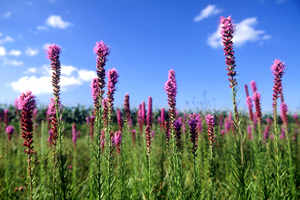 |
This photo of the Shooting
Star Wildflower route and Scenic Byway, a 26-mile stretch of Hwy 56 in
Mower County, took first place in the FHWA Photo Opportunity Awards for
protected native plants. Photo by David Larson
|
A photo of pink blazing stars, an endangered wild flower, against a blue prairie
sky recently won first place in the 2001 Federal Highway Administration Photo
Opportunity Awards in the protected native plants category.
Representing the Shooting Star Wildflower route and Scenic Byway, a 26-mile
stretch of Hwy 56 in Mower County, the photo was one of four awards Mn/DOT received
this week at the context sensitive design workshop held at the University of
Minnesota. Awards honor both the photograph and the project.
Mn/DOT's Office of Environmental Services also received three other third-place
awards for roadside projects.
Bonnie Harper-Lore, FHWA plant community ecologist,
said the awards program, begun in 1994, increases awareness of the value of
"green and growing things" along the roadsides and is an outgrowth of the wildflower
program begun by Lady Bird Johnson, former First Lady. Etched in the crystal
award is a quote from Johnson: "Where flowers bloom, so does hope."
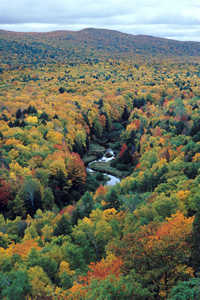 |
|
David Larson earned
another honor for photography: This photo of Michigan's Upper Peninsula
appeared in the July 2002 issue of Minnesota Monthly as part of
its "northern light" competition for amateur photographers.
|
Roadside right of way accounts for 10 million acres of U.S. land, according
to the FHWA. Hwy 56 right of way is home to several rare plants including the
endangered shooting star. According to Harper-Lore, wildflower routes were designated
in the 1980s to protect remnants of Minnesota's natural heritage. She adds that
the Shooting Star route preserves an example of the state’s disappearing tall
grass prairie.
"Mn/DOT has had a tradition of environmental excellence," said Nelrae Succio,
director of district operations division, who accepted the first-place award
on behalf of the department. "Many of our programs have been shared with other
states."
Wildflower routes and scenic byways are examples of context sensitive design,
where projects are integrated into the setting.
Winners of the FHWA photo contest by category were:
-
Protected native plants—Hwy 56 Shooting Star Scenic Byway by David Larson,
Environmental Services, first place; Hwy 56 Shooting Star Scenic Byway by
Kathy Boline, Environmental Services, third place
-
Planted native plants— Hwy 169 in Shakopee by David Larson, Environmental
Services, third place
-
Invasive Species—Biocontrol along I-94/U.S. 52 in St. Paul by Kevin Walker,
Metro Public Affairs, third place
Click here for information about Minnesota
Scenic Byways and context-sensitive
design.
By Sue Stein
|
back

|
 |
Camp Mn/DOT goes online
|
 |
 |
 |
|
Registration deadlines
near for Camp Mn/DOT, a one-day educational event for children ages 4
to 16. Activities will take place the week of July 23. Design by Jane
Greiner
|
With Camp Mn/DOT just five weeks away, registration deadlines loom for potential
campers ages 4 to 16. Registration deadlines and activities vary by location
for the one-day event, which will be held at Central Office and in several districts
during the week of July 23.
A new online registration process should help procrastinators, but space may
become limited, so don’t wait until the last minute to register, advises Nancy
Standal, Camp Mn/DOT statewide co-chair.
Last year, almost 400 children participated statewide.
For more event dates, registration deadlines, contact names and photos from
last year’s event, check out the Camp
Mn/DOT Web site at www.dot.state.mn.us/campmndot/campers/index.html.
|
back

|
|
 |
|



